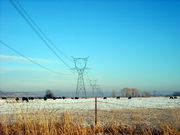Knowledge fuels change - Support energypedia!
For over 10 years, energypedia has been connecting energy experts around the world — helping them share knowledge, learn from each other, and accelerate the global energy transition.
Today, we ask for your support to keep this platform free and accessible to all.
Even a small contribution makes a big difference! If just 10–20% of our 60,000+ monthly visitors donated the equivalent of a cup of coffee — €5 — Energypedia would be fully funded for a whole year.
Is the knowledge you’ve gained through Energypedia this year worth €5 or more?
Your donation keeps the platform running, helps us create new knowledge products, and contributes directly to achieving SDG 7.
Thank you for your support, your donation, big or small, truly matters!
Overhead Power Line
Overview
An overhead power line is an electric power transmission line suspended by towers or poles. Since most of the insulation is provided by air, overhead power lines are generally the lowest-cost method of transmission for large quantities of electric power. Towers for support of the lines are made of wood (as-grown or laminated), steel (either lattice structures or tubular poles), concrete, aluminum, and occasionally reinforced plastics. The bar wire conductors on the line are generally made of aluminum (either plain or reinforced with steel or sometimes composite materials), though some copper wires are used in medium-voltage distribution and low-voltage connections to customer premises.[1]
The invention of the Strain insulator was a critical factor in allowing higher voltages to be used. At the end of the 19th century, the limited electrical strength of Telegraph-style Pin insulators limited the voltage to no more than 69,000 Volts. Today overhead lines are routinely operated at voltages exceeding 765,000 volts between conductors, with even higher voltages possible in some cases.[1]
Classification
Overhead power transmission lines are classified in the electrical power industry by the range of voltages[2]:
| Low voltage |
less than 1000 volts | used for connection between a residential or small commercial customer and the utility. |
| Medium Voltage (Distribution) | between 1000 volts (1 kV) and to about 33 kV | used for distribution in urban and rural areas. |
| High Voltage (Subtransmission if 33-115kV and transmission if 115kV+) | between 33 kV and about 230 kV | used for sub-transmission and transmission of bulk quantities of electric power and connection to very large consumers. |
| Extra High Voltage (Transmission) | over 230 kV, up to about 800 kV | used for long distance, very high power transmission. |
| Ultra High Voltage | higher than 800 kV |
Lines classified as "low voltage" are quite hazardous. Direct contact with (touching) energized conductors still present a risk of electrocution. A major goal of overhead power line design is to maintain adequate clearance between energized conductors and the ground so as to prevent dangerous contact with the line. This is extremely dependent on the voltage the line is running at.
Further Information
- Wikipedia - Overhead power line
- Grid Portal on energypedia
- EMFs.info: Power lines - specific voltages
References
- ↑ 1.0 1.1 Wikipedia.org: http://en.wikipedia.org/wiki/Overhead_power_line
- ↑ Wikipedia.org: http://en.wikipedia.org/wiki/Overhead_power_line#Classification_by_operating_voltage




















